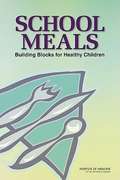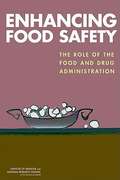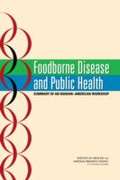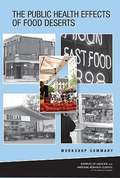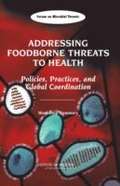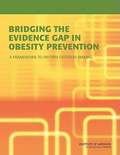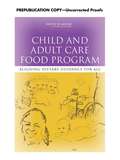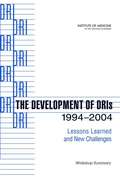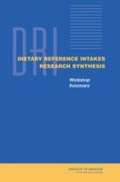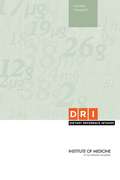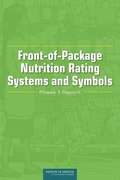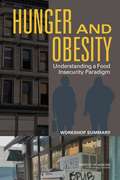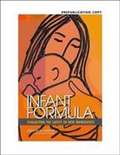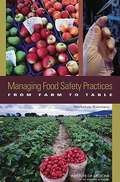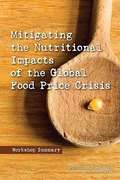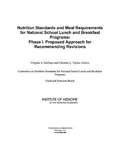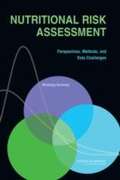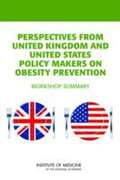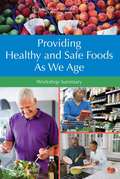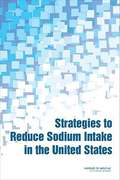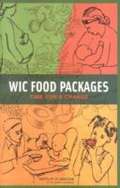- Table View
- List View
School Meals: Building Blocks for Healthy Children
by Institute of MedicineEnsuring that the food provided to children in schools is consistent with current dietary recommendations is an important national focus. Various laws and regulations govern the operation of school meal programs. In 1995, Nutrition Standards and Meal Requirements were put in place to ensure that all meals offered would be high in nutritional quality. School Meals reviews and provides recommendations to update the nutrition standard and the meal requirements for the National School Breakfast and Lunch Programs. The recommendations reflect new developments in nutrition science, increase the availability of key food groups in the school meal programs, and allow these programs to better meet the nutritional needs of children, foster healthy eating habits, and safeguard children's health. School Meals sets standards for menu planning that focus on food groups, calories, saturated fat, and sodium and that incorporate Dietary Guidelines for Americans and the Dietary Reference Intakes. This book will be used as a guide for school food authorities, food producers, policy leaders, state/local governments, and parents.
Enhancing Food Safety: The Role of the Food and Drug Administration
by Institute of Medicine National Research Council of the National AcademiesRecent outbreaks of illnesses traced to contaminated sprouts and lettuce illustrate the holes that exist in the system for monitoring problems and preventing foodborne diseases. Although it is not solely responsible for ensuring the safety of the nation's food supply, the U.S. Food and Drug Administration (FDA) oversees monitoring and intervention for 80 percent of the food supply. The U.S. Food and Drug Administration's abilities to discover potential threats to food safety and prevent outbreaks of foodborne illness are hampered by impediments to efficient use of its limited resources and a piecemeal approach to gathering and using information on risks. Enhancing Food Safety: The Role of the Food and Drug Administration, a new book from the Institute of Medicine and the National Research Council, responds to a congressional request for recommendations on how to close gaps in FDA's food safety systems. Enhancing Food Safety begins with a brief review of the Food Protection Plan (FPP), FDA's food safety philosophy developed in 2007. The lack of sufficient detail and specific strategies in the FPP renders it ineffectual. The book stresses the need for FPP to evolve and be supported by the type of strategic planning described in these pages. It also explores the development and implementation of a stronger, more effective food safety system built on a risk-based approach to food safety management. Conclusions and recommendations include adopting a risk-based decision-making approach to food safety; creating a data surveillance and research infrastructure; integrating federal, state, and local government food safety programs; enhancing efficiency of inspections; and more. Although food safety is the responsibility of everyone, from producers to consumers, the FDA and other regulatory agencies have an essential role. In many instances, the FDA must carry out this responsibility against a backdrop of multiple stakeholder interests, inadequate resources, and competing priorities. Of interest to the food production industry, consumer advocacy groups, health care professionals, and others, Enhancing Food Safety provides the FDA and Congress with a course of action that will enable the agency to become more efficient and effective in carrying out its food safety mission in a rapidly changing world.
Foodborne Disease and Public Health: SUMMARY OF AN IRANIAN-AMERICAN WORKSHOP
by Institute of Medicine National Research Council of the National AcademiesThe Institute of Medicine's Food and Nutrition Board and the National Research Council's Policy and Global Affairs Division convened a workshop in Washington, D.C., entitled Foodborne Disease and Public Health: An Iranian-American Workshop. The overall goals of this workshop were to facilitate the exchange of ideas about foodborne disease and public health and to promote further collaboration among Americans and Iranians on this topic of mutual interest. Experts invited to participate in this workshop addressed a variety of topics, ranging from the surveillance of outbreaks of foodborne illness to approaches to medical training in the Iranian and U.S. educational systems. The workshop was part of a series of cooperative efforts between the United States and Iran as the two countries have collaborated in the past on similar projects relating to foodborne disease.
The Public Health Effects of Food Deserts: Workshop Summary
by Institute of Medicine National Research Council of the National AcademiesThis report from the January 2009 workshop examines neighborhoods and communities that have limited access to affordable and nutritious foods, and describes several approaches to measuring food deserts and their impact on public health. Researchers from the US and Britain evaluate different interventions to ameliorate food desert conditions and identify current research gaps and needs. No index is provided. Annotation ©2010 Book News, Inc. , Portland, OR (booknews. com)
ADDRESSING FOODBORNE THREATS TO HEALTH: Policies, Practices, and Global Coordination
by Institute of Medicine of the National AcademiesThe National Academies Press (NAP)--publisher for the National Academies--publishes more than 200 books a year offering the most authoritative views, definitive information, and groundbreaking recommendations on a wide range of topics in science, engineering, and health. Our books are unique in that they are authored by the nation's leading experts in every scientific field.
Bridging the Evidence Gap in Obesity Prevention: A Framework to Inform Decision Making
by Institute of Medicine of the National AcademiesTo battle the obesity epidemic in America, health care professionals and policymakers need relevant, useful data on the effectiveness of obesity prevention policies and programs. ridging the Evidence Gap in Obesity Prevention identifies a new approach to decision making and research on obesity prevention to use a systems perspective to gain a broader understanding of the context of obesity and the many factors that influence it.
Child and Adult Care Food Program: Aligning Dietary Guidance for All
by Institute of Medicine of the National AcademiesThe Child and Adult Care Food Program (CACFP) is a federally-funded program designed to provide healthy meals and snacks to children and adults while receiving day care at participating family day care homes, traditional child care centers, afterschool facilities, adult care facilities, and emergency shelters. CACFP has the broadest scope of any of the U.S. Department of Agriculture (USDA) food program, serving more than 3 million children and 114,000 adults across the nation. To receive reimbursement for the foods served, participating programs must abide by requirements set by the USDA. Child and Adult Care Food Program assesses the nutritional needs of the CACFP population based on Dietary Guidelines for Americans and the Dietary Reference Intakes (DRIs) and makes recommendations for revisions to the CACFP meal requirements. The book outlines meal requirements that include food specifications that could be used for specific meals and across a full day, covering all age groups from infants to older adults and meal patterns designed for use in a variety of settings, including in-home care and in large centers. By implementing these meal requirements, consumption of fruits, vegetables, and whole-grain rich foods will increase while consumption of solid fats, added sugars, and sodium will decrease. Not only will this address the high prevalence of childhood obesity, it will also help to achieve consistency with the standards and regulations of other USDA nutrition assistance programs, particularly the Supplemental Nutrition Program for Women, Infants, and Children (WIC), and the National School Lunch and School Breakfast programs. Child and Adult Care Food Program makes practical recommendations that would bring CACFP meals and snacks into alignment with current dietary guidance. The book will serve as a vital resource for federal and state public health officials, care providers working in child and adult day care facilities, WIC agencies, officials working with the National School Lunch and School Breakfast programs, and other organizations serving at-risk populations.
The Development of DRIs 1994-2004: Preliminary Workshop Summary
by Institute of Medicine of the National AcademiesThe National Academies Press (NAP)--publisher for the National Academies--publishes more than 200 books a year offering the most authoritative views, definitive information, and groundbreaking recommendations on a wide range of topics in science, engineering, and health. Our books are unique in that they are authored by the nation's leading experts in every scientific field.
Dietary Reference Intakes Research Synthesis Workshop Summary
by Institute of Medicine of the National AcademiesThe National Academies Press (NAP)--publisher for the National Academies--publishes more than 200 books a year offering the most authoritative views, definitive information, and groundbreaking recommendations on a wide range of topics in science, engineering, and health. Our books are unique in that they are authored by the nation's leading experts in every scientific field.
DRI Dietary Reference Intakes Calcium Vitamin D
by Institute of Medicine of the National AcademiesCalcium and vitamin D are essential nutrients for the human body. Establishing the levels of these nutrients that are needed by the North American population is based on the understanding of the health outcomes that calcium and vitamin D affect. It is also important to establish how much of each nutrient may be "too much." Dietary Reference Intakes for Calcium and Vitamin D provides reference intake values for these two nutrients. The report updates the DRI values defined in Dietary Reference Intakes for Calcium, Phosphorous, Magnesium, Vitamin D, and Fluoride, the 1997 study from the Institute of Medicine. This 2011 book provides background information on the biological functions of each nutrient, reviews health outcomes that are associated with the intake of calcium and vitamin D, and specifies Estimated Average Requirements and Recommended Dietary Allowances for both. It also identifies Tolerable Upper Intake Levels, which are levels above wish the risk for harm may increase. The book includes an overview of current dietary intake in the U.S. and Canada, and discusses implications of the study. A final chapter provides research recommendations. The DRIs established in this book incorporate current scientific evidence about the roles of vitamin D and calcium in human health and will serve as a valuable guide for a range of stakeholders including dietitians and other health professionals, those who set national nutrition policy, researchers, the food industry, and private and public health organizations and partnerships.
Front-of-Package Nutrition Rating Systems and Symbols: Phase I Report
by Institute of Medicine of the National AcademiesThe federal government requires that most packaged foods carry a standardized label--the Nutrition Facts panel--that provides nutrition information intended to help consumers make healthful choices. In recent years, manufacturers have begun to include additional nutrition messages on their food packages. These messages are commonly referred to as 'front-of-package' (FOP) labeling. As FOP labeling has multiplied, it has become easy for consumers to be confused about critical nutrition information. In considering how FOP labeling should be used as a nutrition education tool in the future, Congress directed the Centers for Disease Control and Prevention to undertake a two-phase study with the IOM on FOP nutrition rating systems and nutrition-related symbols. The Food and Drug Administration is also a sponsor. In Phase 1 of its study, the IOM reviewed current systems and examined the strength and limitations of the nutrition criteria that underlie them. The IOM concludes that it would be useful for FOP labeling to display calorie information and serving sizes in familiar household measures. In addition, as FOP systems may have the greatest benefit if the nutrients displayed are limited to those most closely related to prominent health conditions, FOP labeling should provide information on saturated fats, trans fats, and sodium.
Hunger and Obesity: Understanding a Food Insecurity Paradigm - Workshop Summary
by Institute of Medicine of the National AcademiesAt some point during 2009, more than 17 million households in the United States had difficulty providing enough food for all their members because of a lack of resources. In more than one-third of these households, the food intake of some household members was reduced and normal eating patterns were disrupted due to limited resources. The Workshop on Understanding the Relationship Between Food Insecurity and Obesity was held to explore the biological, economic, psychosocial, and other factors that may influence the relationship between food insecurity, overweight, and obesity in the United States. Hunger and Obesity examines current concepts and research findings in the field. The report identifies information gaps, proposes alternative approaches to analyzing data, recommends new data that should be collected, and addresses the limitations of the available research.
Infant Formula: Evaluating The Safety Of New Ingredients
by Institute of Medicine of the National AcademiesInfant formulas are unique because they are the only source of nutrition for many infants during the first 4 to 6 months of life. They are critical to infant health since they must safely support growth and development during a period when the consequences on inadequate nutrition are most severe. Existing guidelines and regulations for evaluating the safety of conventional food ingredients (e.g., vitamins and minerals) added to infant formulas have worked well in the past; however they are not sufficient to address the diversity of potential new ingredients proposed by manufacturers to develop formulas that mimic the perceived and potential benefits of human milk. This book, prepared at the request of the Food and Drug Administration (FDA) and Health Canada, addresses the regulatory and research issues that are critical in assessing the safety of the addition of new ingredients to infants.
Managing Food Safety Practices FROM FARM TO TABLE: Workshop Summary
by Institute of Medicine of the National AcademiesLegal regulations and manufacturers' monitoring practices have not been enough to prevent contamination of the national food supply and protect consumers from serious harm. In addressing food safety risks, regulators could perhaps better ensure the quality and safety of food by monitoring food production not just at a single point in production but all along the way, from farm to table. Recognizing the troubled state of food safety, the Institute of Medicine's (IOM) Food Forum met in Washington, DC, on September 9, 2008, to explore the management of food safety practices from the beginning of the supply chain to the marketplace.
Mitigating the Nutritional Impacts of the Global Food Price Crisis: Workshop Summary
by Institute of Medicine of the National AcademiesIn 2007 and 2008, the world witnessed a dramatic increase in food prices. The global financial crisis that began in 2008 compounded the burden of high food prices, exacerbating the problems of hunger and malnutrition in developing countries. The tandem food price and economic crises struck amidst the massive, chronic problem of hunger and undernutrition in developing countries. National governments and international actors have taken a variety of steps to mitigate the negative effects of increased food prices on particular groups. The recent abrupt increase in food prices, in tandem with the current global economic crisis, threatens progress already made in these areas, and could inhibit future efforts. The Institute of Medicine held a workshop, summarized in this volume, to describe the dynamic technological, agricultural, and economic issues contributing to the food price increases of 2007 and 2008 and their impacts on health and nutrition in resource-poor regions. The compounding effects of the current global economic downturn on nutrition motivated additional discussions on these dual crises, their impacts on the nutritional status of vulnerable populations, and opportunities to mitigate their negative nutritional effects.
Nutrition Standards and Meal Requirements for National School Lunch and Breakfast Programs: Phase I. Proposed Approach for Recommending Revisions
by Institute of Medicine of the National AcademiesThe National School Breakfast Program feeds 10 million children each day, and the National School Lunch Program feeds more than 30 million students. Yet the national nutrition standards and meal requirements for these meals were created more than a decade ago, making them out of step with recent guidance about children's diets. With so many children receiving as much as 50 percent of their daily caloric intake from school meals, it is vital for schools to provide nutritious food alongside the best possible education for the success of their students. At the request of U.S. Department of Agriculture (USDA), the Institute of Medicine assembled a committee to recommend updates and revisions to the school lunch and breakfast programs. The first part of the committee's work is reflected in the December 2008 IOM report Nutrition Standards and Meal Requirements for National School Lunch and Breakfast Programs: Phase I. Proposed Approach for Recommending Revisions. Phase II of the report is expected in Fall 2009. This first report provides information about the committee's approach as it reviews the school lunch and breakfast programs. In the report's second part, the committee will share its findings and recommendations to bring these meals more in line with today's dietary guidelines. The committee welcomes public comments about its intended approach. An open forum will be held January 28, 2009 in Washington, DC to receive input from the public. Please go to http://www.iom.edu/fnb/schoolmeals for details or email FNBSchoolMeals@nas.edu with any input.
NUTRITIONAL RISK ASSESSMENT: Perspectives, Methods, and Data Challenges
by Institute of Medicine of the National AcademiesThe National Academies Press (NAP)--publisher for the National Academies--publishes more than 200 books a year offering the most authoritative views, definitive information, and groundbreaking recommendations on a wide range of topics in science, engineering, and health. Our books are unique in that they are authored by the nation's leading experts in every scientific field.
Perspectives from United Kingdom and United States Policy Makers on Obesity Prevention: Workshop Summary
by Institute of Medicine of the National AcademiesBoth the United Kingdom and United States are grappling with nationwide epidemics of obesity. Obesity contributes to diabetes, cardiovascular disease, and some cancers, among other diseases. Although many people are aware of obesity's causes and consequences, few see it as a problem for their own families--despite clinical evidence to the contrary. Given this disconnect between perception and reality, policy makers in both countries struggle to find a way to reach people to encourage change. The IOM brought together policy makers from the U.K. and U.S. for a workshop on October 22, 2009, to discuss the challenges of and promising approaches to the struggle against obesity. Presenters spoke about current policies, programs, and partnerships that are addressing the obesity epidemic and evidence for effective strategies to change perception and behaviors. The workshop, summarized in this document, provided an opportunity for both countries to learn from each other's efforts and to consider how to apply new strategies at home.
Providing Healthy and Safe Foods As We Age: Workshop Summary
by Institute of Medicine of the National AcademiesDoes a longer life mean a healthier life? The number of adults over 65 in the United States is growing, but many may not be aware that they are at greater risk from foodborne diseases and their nutritional needs change as they age. The IOM's Food Forum held a workshop October 29-30, 2009, to discuss food safety and nutrition concerns for older adults.
Seafood Choices: Balancing Benefits And Risks
by Institute of Medicine of the National AcademiesThe fragmented information that consumers receive about the nutritional value and health risks associated with fish and shellfish can result in confusion or misperceptions about these food sources. Consumers are therefore confronted with a dilemma: they are told that seafood is good for them and should be consumed in large amounts, while at the same time the federal government and most states have issued advisories urging caution in the consumption of certain species or seafood from specific waters. Seafood Choices carefully explores the decision-making process for selecting seafood by assessing the evidence on availability of specific nutrients (compared to other food sources) to obtain the greatest nutritional benefits. The book prioritizes the potential for adverse health effects from both naturally occurring and introduced toxicants in seafood; assesses evidence on the availability of specific nutrients in seafood compared to other food sources; determines the impact of modifying food choices to reduce intake of toxicants on nutrient intake and nutritional status within the U.S. population; develops a decision path for U.S. consumers to weigh their seafood choices to obtain nutritional benefits balanced against exposure risks; and identifies data gaps and recommendations for future research. The information provided in this book will benefit food technologists, food manufacturers, nutritionists, and those involved in health professions making nutritional recommendations.
Strategies to Reduce Sodium Intake in the United States
by Institute of Medicine of the National AcademiesReducing the intake of sodium is an important public health goal for Americans. Since the 1970s, an array of public health interventions and national dietary guidelines has sought to reduce sodium intake. However, the U.S. population still consumes more sodium than is recommended, placing individuals at risk for diseases related to elevated blood pressure.Strategies to Reduce Sodium Intake in the United States evaluates and makes recommendations about strategies that could be implemented to reduce dietary sodium intake to levels recommended by the Dietary Guidelines for Americans. The book reviews past and ongoing efforts to reduce the sodium content of the food supply and to motivate consumers to change behavior. Based on past lessons learned, the book makes recommendations for future initiatives. It is an excellent resource for federal and state public health officials, the processed food and food service industries, health care professionals, consumer advocacy groups, and academic researchers.
Wic Food Packages: Time For A Change
by Institute of Medicine of the National AcademiesThe Special Supplemental Nutrition Program for Women, Infants, and Children (the WIC program) has promoted the health of low-income families for more than 30 years by providing nutrition education, supplemental food, and other valuable services. The program reaches millions of families every year, is one of the largest nutrition programs in the United States, and is an important investment in the nation’s health. The U.S. Department of Agriculture charged the Institute of Medicine with creating a committee to evaluate the WIC food packages (the list of specific foods WIC participants obtain each month). The goal of the study was to improve the quality of the diet of WIC participants while also promoting a healthy body weight that will reduce the risk of chronic diseases. The committee concluded that it is time for a change in the WIC food packages and the book provides details on the proposed new food packages, summarizes how the proposed packages differ from current packages, and discusses the rationale for the proposed packages.
Weight Watchers 5 and Under
by Weight Watchers InternationalLooking for tasty, hassle-free recipes that make the most of your daily POINTS Target? Weight Watchers Five & Under gives you 50 best bets to keep your eating plan on track (34 recipes follow the Flex Plan and 16 follow the Core Plan). Look inside for these delicious mealtime solutions: BREAKFAST Shirred Eggs with Tomato (2 POINTS value) German Pancake with Fresh Berries {4 POINTS value) LUNCH Spicy Grilled Chicken with Salsa Vinaigrette (5 POINTS value) Creamy Clam Chowder with Fresh Tomatoes (4 POINTS value) DINNER Italian-Style Stuffed Peppers (4 POINTS value) Thai Curry Soup with Shrimp (5 POINTS value) SNACKS Sweet Onion-and-Coconut Crab Dip (1 POINTS value) Chocolate Banana Pops (4 POINTS value)
Weight Watchers Best Ever Desserts
by Weight Watchers InternationalFrom home-style cookies to show-stopping cakes, everyone loves a sweet ending! In Best-Ever Desserts, you will find every treat from cakes, pies, cookies, and quick breads to fruity, creamy, and frozen desserts and even luscious sauces. Among our favorites are these: Chocolate-Glazed Chocolate Bundt Cake White and Dark Chocolate Chunk Cookies Berry Shortcakes Chocolate-Hazelnut Meringue Pie Watermelon Bombe Old-Fashioned Apple Crumb Pie Plum and Toasted Almond Dessert Pizza Baby Pavlovas Plus, we've whipped up a chapter of 10-Minute Sensations that will get you out of the kitchen fast. As in every Weight Watchers cookbook, recipes include complete nutritional analysis and the POINTS?" value. So the next time you crave a sweet, look in Best-Ever Desserts for a finale guaranteed to be irresistibly delicious.
Weight Watchers Cook It Quick
by Weight Watchers InternationalGot a half hour? Then you've got dinner. Weight Watchers Cook It Quick! solves your daily dinnertime dilemma-deliriously. With more than 150 speedy, savory recipes, Weight Watchers Cook It Quick! takes some of the work out of your workday by supplying you with fabulous fix-it-fast ideas for all your evening meals. Plus, we offer helpful hints for easy substitutions and tasty tips for making these recipes even faster and more delicious, so there's no excuse for not cooking the family a homemade meal. Just Check out what's in Weight Watchers Cook It Quick Salads to Sink Your Teeth Into Savory Soups & Stews Pizza, Sandwiches, & Wraps All-in-the-Family Favorites Everybody Loves Pasta (Grains, too!) Flash in the Pan: Stir Fries & Skillet Suppers Elegantly Easy About Last Night.. .Slow-Cooker Recipes Bonus! 10 in 15: Best Ever 15-Minute Recipes; Naturally, each recipe includes complete nutrition information and POINTS. Also included in this food-filled collection: how to make perfect pasta every time; yummy ideas for turning take-out food into a healthy dinner; clever quick-lunch suggestions; and more., don't miss our handy Metric Conversion Chart. With so many fabulous 30-minutes-or-less recipes at your fingertips, what are you waiting for? Cook it Quick
